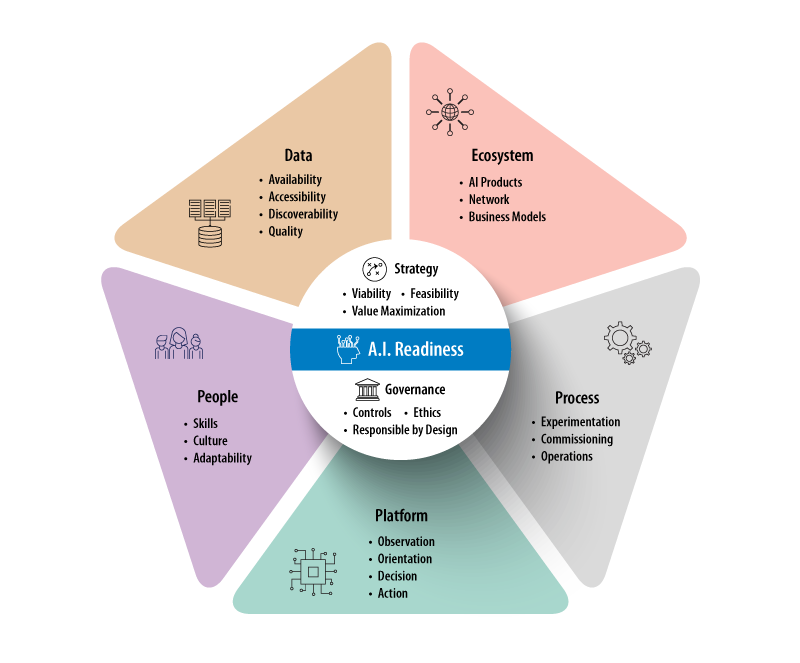Insights
- AI success is hindered by several barriers, cutting across a spectrum of organizational fronts.
- To overcome these pain points, we propose an AI readiness framework, comprising five core components — data, ecosystem, process, platform, and people — guided by two central tenets: strategy and governance.
- There are many data types in the AI era. All must be managed through four focus areas: organizing and fingerprinting data, vertically integrated control functions, zero-trust privacy and regulatory compliance, and governed consumption.
- This data governance blueprint promotes responsible by design; we suggest an AI council to govern and guide AI initiatives, creating a feedback loop for continuous improvement.
- Firms should also use a platform approach to data, single pane of glass operations, turn sceptical employees into AI advocates, take an ecosystem perspective, and finally, develop a portfolio of AI initiatives.

AI is a transformative technology, but becoming AI-first requires reimagining businesses and processes, embedding AI and data into the organizational fabric. Companies are increasing their spend on Generative AI (report), yet only a quarter of executives are satisfied with their AI initiatives (report). Our research shows this is due to the lack of enterprise readiness for data and AI.
Firms face many challenges – technical and non-technical – in going AI-first.
- Unclear AI strategy – leaders struggle to properly identify AI value streams; they often prioritize low-impact remedial initiatives, instead of forward-looking generative ones.
- Expanding enterprise data universe for AI - The AI era expands beyond traditional analytical and transactional data to many data types (user generated content, synthetic data, machine data, ecosystem, and third-party data)
- Trust – Concern over trust, responsibility and ethics impede widespread adoption of enterprise AI.
- Skills and proclivity – employees are not accustomed to working with AI, and the human–machine interface could lead to conflicts in multiple areas.
- Costs and unclear value – AI models are expensive to train; delayed and unclear benefits further intensify concerns.
- Data – the primary challenge voiced by executives in our research; data privacy, security, and useability constrain AI adoption.
To address these concerns, we developed an AI readiness framework consisting of five components (data, ecosystem, process, platform, and people), guided by overarching tenets of strategy and governance.
The seven areas are valuable individually yet create significantly greater value as complementary capabilities.
As an example, the framework helped a US based coffee company use AI to predict and deliver just-in-time inventory to over 20,000 stores in under 4 hours. The combination of framework components enabled the firm to transition from promising experiment to adoption at scale.
Figure 1. The AI readiness framework

Source: Infosys
Given that data is a leading challenge for AI, firms need to first establish an effective data estate, ensuring data assets are available, accessible, discoverable, and of high quality. Successful firms will bring all data – and their unique challenges - under management. In our AI research and client work, four successful data practices stand out:
- Organize and fingerprint data: Autonomously discover data sets, “fingerprint” them for metadata, catalogue for common understanding of AI initiatives, and finally ensure data is accurate and of high veracity.
- Control functions for better governance: Access security; distribution and data rights management; consent management and access control for user generated content; data monitoring; synthetic data versioning; and governance to protect against IP, legal, and privacy breaches.
- Zero-trust privacy and regulatory compliance: Continuously track regulations, as well as identify and deploy capabilities that lead to compliance.
- Governed consumption: Define user groups to consume model output, and ensure models are current and perform effectively.
This data also needs to be connected, protected, and consumed. The data governance blueprint has emerged as a tool to aid AI readiness and governance, data health, data management, and security.
This leads to responsible by design, where inputs are filtered, leading to improvement in data readiness indicators, including error rate, data quality score, and unique data users.
Five recommendations to go AI-first
AI readiness extends beyond data readiness and governance. Executives and practitioners should also address other areas in the AI readiness framework, according to their unique requirements and maturity level.
- Platform approach to data, where the data estate is separated into well-defined layers, including a smart data fabric foundation.
- Single pane of glass operations, to reduce friction and increase visibility across operations.
- Employees as AI evangelists; building an environment of Human-Machine collaboration.
- Ecosystem perspective, with shared intelligence as the currency that creates non-linear value.
- AI portfolio, created to maximize value across innovation, operating model, and talent.
Using these practices, a leading mining company reduced machinery fault identification to under 5 minutes using AI. This predictive approach enabled them to proactively repair remote equipment, increasing the key parameter of mean time to failure.
For more firms to realize the benefits, the C-suite needs to actively sponsor the AI preparation journey. The good news is that CEOs and CIOs already sponsor generative AI initiatives in over a quarter of firms in the U.S. This type of commitment and leadership nurtures data-ready strategy, committed resources, and scaled adoption of this transformative emerging technology.





